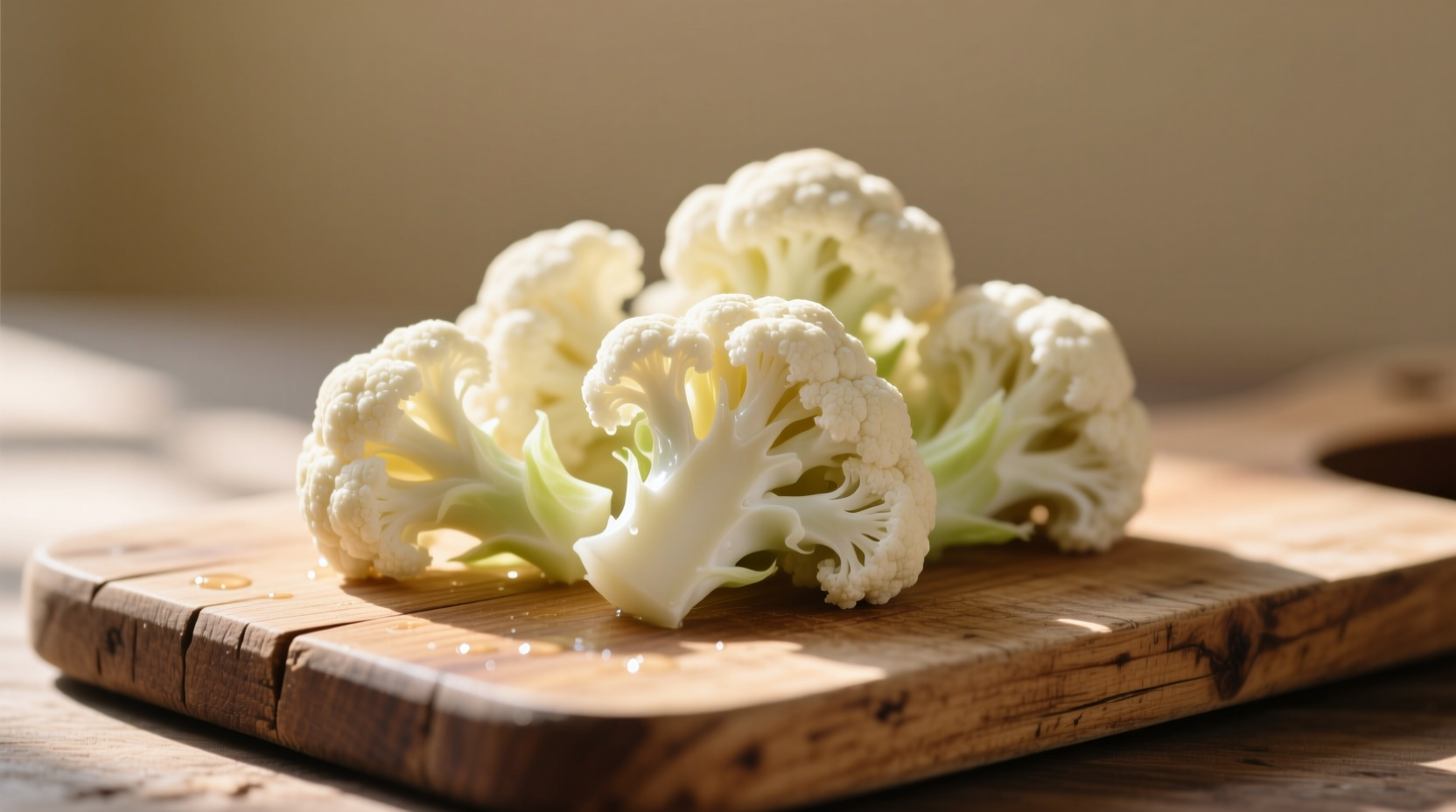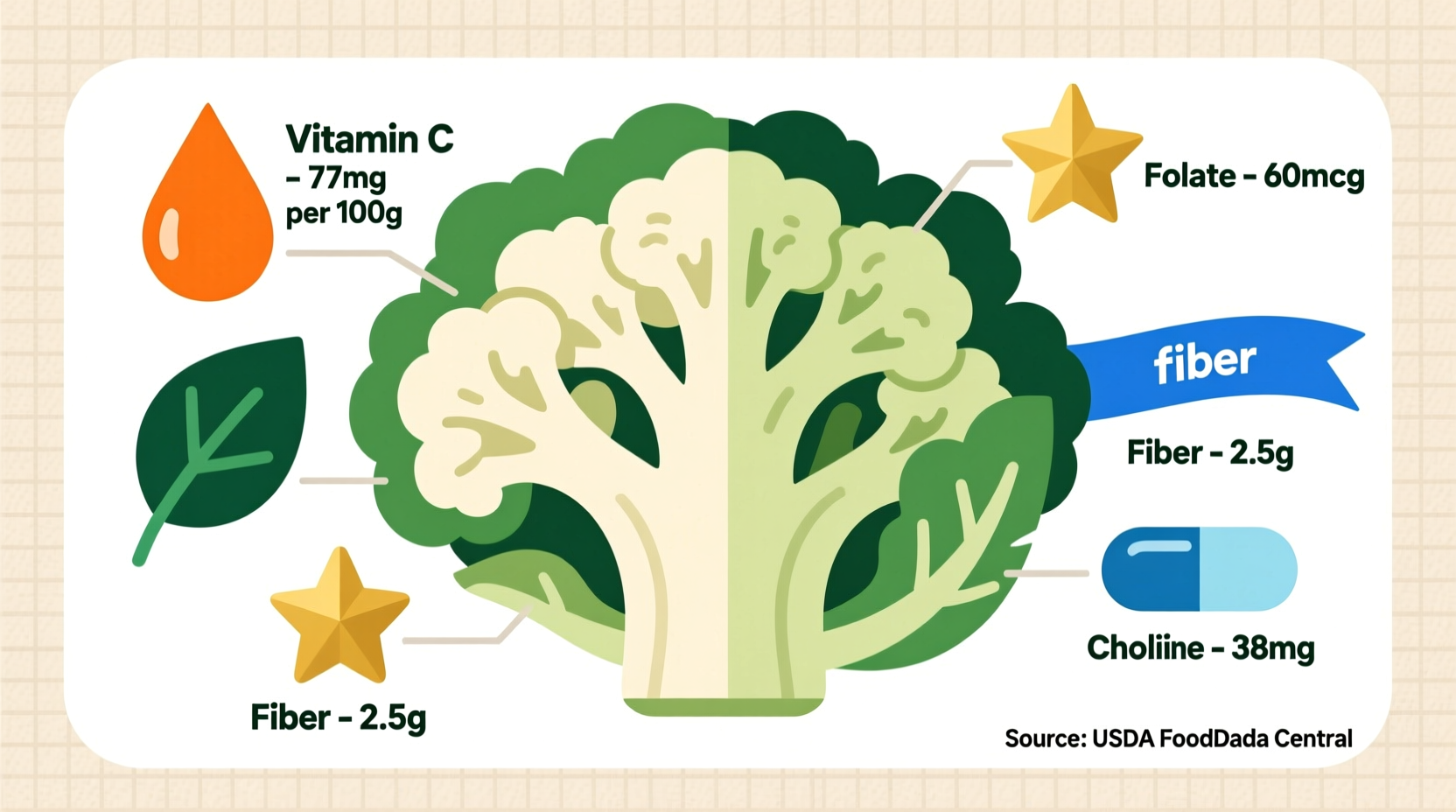Discover exactly what makes this versatile cruciferous vegetable a nutritional powerhouse. Whether you're managing dietary restrictions, optimizing athletic performance, or simply seeking healthier meal options, understanding cauliflower's complete nutrient profile helps you make informed food choices that support your specific health goals.
Complete Cauliflower Nutrition Profile: What's Inside Every Serving
Based on USDA FoodData Central measurements, raw cauliflower provides exceptional nutrition density. A standard 100-gram serving (about 3/4 cup of florets) contains:
| Nutrient | Amount per 100g | %DV* |
|---|---|---|
| Calories | 25 | 1% |
| Protein | 1.9g | 4% |
| Dietary Fiber | 2g | 7% |
| Vitamin C | 48.2mg | 77% |
| Vitamin K | 15.5μg | 20% |
| Folate (B9) | 57μg | 14% |
| Vitamin B6 | 0.18mg | 15% |
| Potassium | 299mg | 9% |
*Percent Daily Values based on a 2,000 calorie diet. Source: USDA FoodData Central, 2023
Key Nutrients and Their Health Impact
Vitamin C: Beyond Immunity Support
Cauliflower's impressive vitamin C content (48.2mg per 100g) provides multiple benefits beyond immune support. This antioxidant protects cells from damage, enhances iron absorption from plant foods, and supports collagen production for healthy skin. Unlike citrus fruits where vitamin C degrades quickly, cauliflower maintains its vitamin C content longer during storage - retaining up to 90% after two weeks refrigerated according to research published in the Journal of Agricultural and Food Chemistry.
Choline: The Brain-Boosting Nutrient
Often overlooked, cauliflower contains 14.5mg of choline per 100g - more than most vegetables. This essential nutrient supports brain development, nerve function, and liver health. The National Institutes of Health recognizes choline as particularly important during pregnancy for fetal brain development. One cup of cauliflower provides approximately 10% of the adequate intake level for adults.
Fiber Composition: Soluble vs Insoluble
Cauliflower's fiber content works through two mechanisms: soluble fiber (which forms a gel-like substance) helps regulate blood sugar and cholesterol, while insoluble fiber promotes digestive regularity. The 2g of fiber per 100g serving represents a favorable 3:1 ratio of insoluble to soluble fiber, making it effective for both digestive health and metabolic regulation.

How Cooking Methods Affect Nutrient Retention
Your preparation method significantly impacts cauliflower's nutritional value. Research from the National Center for Biotechnology Information shows:
- Steaming (5 minutes): Preserves 90% of vitamin C and 100% of glucosinolates (cancer-fighting compounds)
- Boiling (10 minutes): Causes 30-40% loss of water-soluble vitamins
- Roasting (20 minutes at 400°F): Enhances antioxidant availability while preserving most nutrients
- Raw consumption: Maximizes enzyme activity and certain nutrient levels
For optimal nutrient retention, steam cauliflower until just tender-crisp. This method preserves the maximum amount of heat-sensitive vitamins while making certain antioxidants more bioavailable.
Cauliflower vs Other Cruciferous Vegetables: Nutritional Comparison
While all cruciferous vegetables offer health benefits, their nutrient profiles differ significantly:
| Nutrient (per 100g) | Cauliflower | Broccoli | Brussels Sprouts |
|---|---|---|---|
| Vitamin C | 48.2mg | 89.2mg | 85mg |
| Vitamin K | 15.5μg | 101.6μg | 177μg |
| Folate | 57μg | 63μg | 61μg |
| Fiber | 2g | 2.6g | 3.8g |
| Calories | 25 | 34 | 43 |
Source: USDA FoodData Central, 2023
Cauliflower stands out for its versatility and lower calorie density while still providing substantial nutrition. It contains unique compounds like sulforaphane precursors that convert to active forms during chewing and digestion, supporting the body's natural detoxification processes.
Practical Applications: Maximizing Nutritional Benefits
Dietary Integration Strategies
For those managing specific health conditions, cauliflower offers targeted benefits:
- Weight management: Its high water content (92%) and low calorie density make it ideal for volume eating
- Diabetes support: The 2g of fiber per serving helps moderate blood sugar response
- Heart health: Potassium content supports healthy blood pressure regulation
- Digestive wellness: Contains glucoraphanin which feeds beneficial gut bacteria
Nutrient Synergy Pairings
Combine cauliflower with these foods to enhance nutrient absorption:
- Vitamin C + Iron: Pair with lentils or spinach to boost non-heme iron absorption
- Fat-soluble vitamins: Add olive oil or avocado to increase absorption of vitamins K and carotenoids
- Enzyme activation: Include mustard seeds (which contain myrosinase) to maximize sulforaphane formation
Limitations and Considerations
While highly nutritious, cauliflower has some context-specific limitations:
- Thyroid function: Contains goitrogens which may interfere with iodine uptake when consumed raw in extremely large quantities (typically not a concern with normal dietary intake)
- Digestive sensitivity: The raffinose content may cause gas in some individuals - cooking reduces this effect
- Nutrient variability: Soil quality and growing conditions can affect nutrient density by up to 30% according to agricultural studies
For most people, these considerations don't outweigh cauliflower's substantial benefits. Those with specific thyroid conditions should consult their healthcare provider about appropriate consumption levels.
Seasonal Availability and Nutrient Optimization
Cauliflower's nutritional profile changes throughout its growing season. Winter-harvested cauliflower typically contains 15-20% more vitamin C than summer varieties due to cooler temperatures stimulating antioxidant production. The peak season (October through March in North America) offers both better flavor and higher nutrient density. When selecting cauliflower, choose heads with tight, creamy-white florets and fresh green leaves for maximum freshness and nutrient retention.











 浙公网安备
33010002000092号
浙公网安备
33010002000092号 浙B2-20120091-4
浙B2-20120091-4